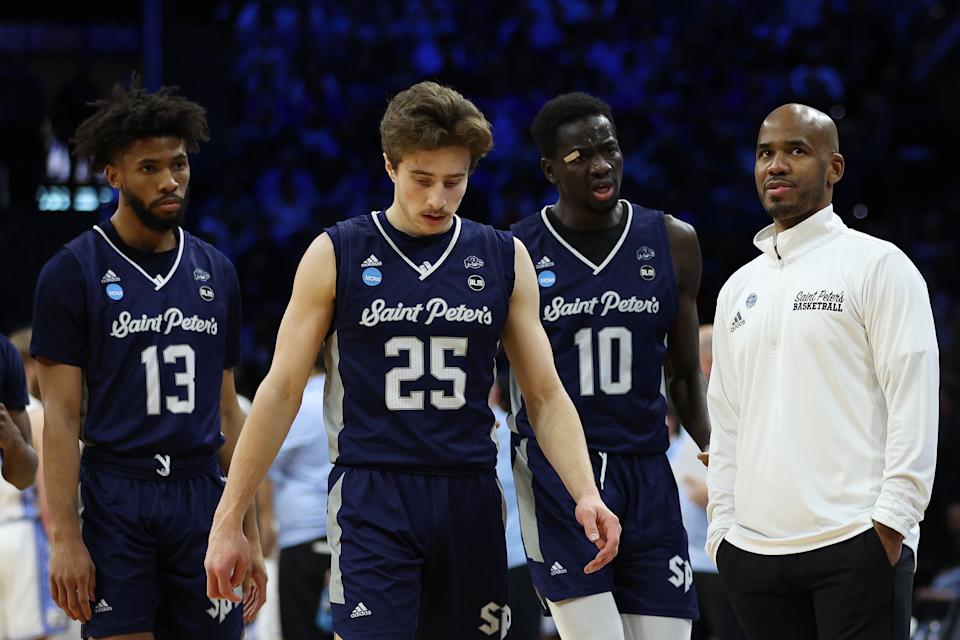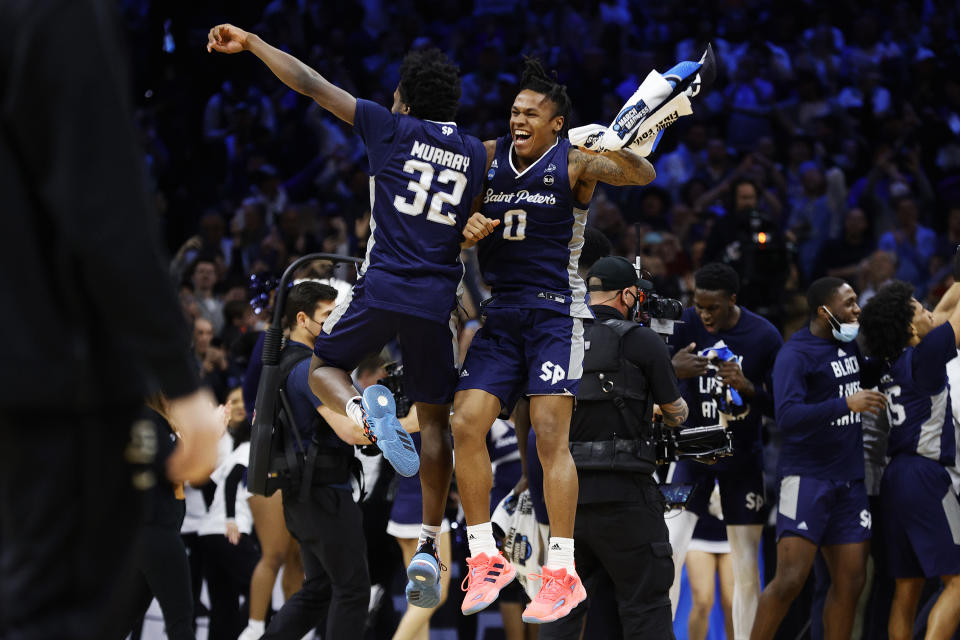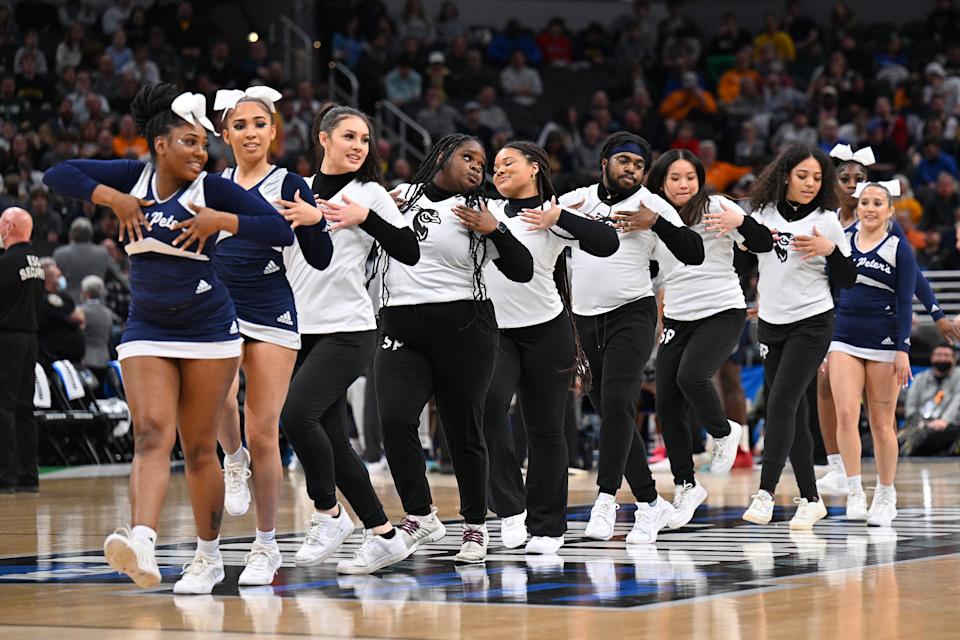PHILADELPHIA — With one minute and 21 seconds remaining in the most magical week of their lives, with spotlights dimming and reality about to strike, the seven men who’d inspired millions huddled tight.
They knew, a little after 7 p.m. here on Sunday, that the end was near, that fairy dust had lapsed. College basketball’s aristocracy had risen to restore order. The Saint Peter’s Peacocks, America’s darlings, had been no match for North Carolina. Soon, they’d exit the NCAA tournament stage right.
But for 11 days, they’d done the unthinkable. They’d captured hearts and minds across the globe. They’d defied resource imbalances and upended power structures and “made history,” head coach Shaheen Holloway said, which is why he stopped them at the scorer’s table Sunday night, untucked jerseys and gloomy faces and all. They draped their arms around one another, and listened.
Then they retreated to their bench. They scraped away tears. They trudged through a handshake line, then back to their locker room, where the atmosphere was glum. They walked through frigid hallways, their hands in pockets, past rumbling refrigerator carts and out into a blustery Philly night. They boarded a bus and climbed back into relative obscurity.
They’ll go to class on Monday and Tuesday and beyond, and sure, they’ll get a few more selfie requests. Perhaps a standing ovation, definitely a bit more attention. But normal life will resume. This March Madness run never will. Their roster will change. Their coach might leave. Their story, in many ways, is over.
But it will endure, because its lessons are indelible. Its impact, though intangible, was meaningful. Holloway doesn’t quite know what, exactly, its legacy will be, but as he pulled his starters from Sunday’s game, and gathered them one final time, he told them: “I’m proud of you. Keep your heads high.”
Because he knows, without a doubt, that their story is a remarkable one. And “you guys,” he later told dozens of reporters, “should write a lot about it.”


‘We’re going to make a run’
Saint Peter’s was the ultimate underdog, a team of overlooked players representing an overlooked commuter school and a student body of overlooked kids, and that’s why its March Madness run meant so much to so many. Some 75% of those students are minorities. Nearly half are Hispanic. Almost all, 99%, receive financial aid. Many are first-generation college students. Many have been disadvantaged, to some extent, by an unjust society. The university became their pathway to a more prosperous life.
Their basketball team hails from Jersey, like most Saint Peter’s undergrads, but also from Puerto Rico, Mali, the Central African Republic and Senegal. And it isn’t siloed like athletes at some massive state schools. “Everybody knows everybody,” junior guard Daryl Banks III said. Point guard Matthew Lee said he’d met non-athletes from India, Colombia and the Dominican Republic, and from all sorts of backgrounds within the U.S. “It’s just so many different cultures coming together,” he said, and the school’s diversity, he added, was one of its best qualities.
Its basketball coach, who’s from Queens, was also an underdog, an undersized point guard in his day. Holloway bounced around Europe and minor leagues after a standout amateur career, then spent a decade as an assistant coach. When Saint Peter’s offered him its head job in 2018, it was rated the worst in the Metro Atlantic Athletic Conference, which was rated the 28th-best conference out of 32 in Division I. But he took it.
The program’s distinguishing quality, in some basketball circles, had been dingy, sometimes defective facilities. Just last decade, unpaid assistant coaches worked in offices that were “unsanitary,” often either sweltering or frigid, and occasionally flooded. There were ceiling leaks, including one that postponed a game. There were pipes that burst, and hot water that went cold, and heat that went off, until recent upgrades.
The team practiced and played at the Yanitelli Center, which opened in 1975 with fold-away bleachers at a cost of $6 million. Joe Schmo students could use it. Jersey City residents could rent it, and often did, for parties and other events that occasionally conflicted with practice. Timbs scuffed up the floor. Swimmers and screaming kids would cross paths with opposing teams at the locker rooms.
When recruits visited, Holloway rarely showed them any of this. He’d sell something less tangible, a vision for how he’d develop them and the program, and for what they could achieve together.
In 2019, he landed a six-member recruiting class of overlooked kids who believed him. Doug Edert and Banks — who admittedly didn’t like Edert much in high school — were the first two on board, and became “brothers.” Another two of the six, the Drame twins, Hassan and Fousseyni, would tell their classmates: “We’re going to make a run.”
When anybody doubted, they’d respond with three simple words: “Time will tell.”
And when they encountered Player of the Year candidates, and 7-foot-4 monsters? When they encountered universities with 10 times as many students, and 100 times as much money endowed? When they encountered programs who’d made a combined 39 Final Fours, and with assistant coaches making more money than Holloway?
“We have one mentality: Whoever we’re playing, if they put their shoes on, and put a jersey [on], we do the same thing,” Hassan Drame said.
The names on jerseys don’t matter, Fousseyni added. “We don’t really know those names. All we see is a player.”
They approached basketball as hope, with a mantra that Hassan expressed Saturday. “No matter what,” he said, “one thing will not betray you: The work that you put in.”


‘It’s been amazing to be recognized’
But in life, of course, work so often goes unnoticed and unrewarded. Effort alone can’t undo society’s inequities. What made the Saint Peter’s Peacocks so inspiring was that, for 11 unforgettable days, in this basketball bubble broadcast to the world, effort did.
For 11 days, a dozen underdogs shone a spotlight on thousands of them, and what it revealed was beauty that so often goes unseen. It revealed stories begging to be told, and indescribable joy on the faces of people who finally did feel seen. They were players, like Hassan Drame, who beamed during a breakout interview with a few reporters; but also so many others who came along for the ride. They were local pub owners and players’ neighbors; faculty and alums; students with no interest in basketball and Jersey City residents with no connection to the school.
They were, for example, the Peacocks’ spirit squad, who, due to budgetary restraints, did not travel to Indianapolis for the first round. Thanks to the upset of Kentucky, they attracted the attention of NBCUniversal’s Peacock TV, which got them to Indy in time for the second round.
The following week, they bussed to Philly, and they were giddy. The chance to toss clothing items to fans, which for many cheerleaders is a mundane activity, made them beam. They soaked up the entire scene. During one timeout on Sunday, they initially struggled with a simple cheerleading stunt, which put a crowd of 20,155 on edge. But in the second half, they nailed another one, and induced a deafening roar. Middle-age men stood and pumped their fists. The spirit squad, despite their team’s 20-point deficit, looked overjoyed.
The whole experience, two members of it said, had been “surreal.” I approached them in a hallway afterward and asked if any would like to be interviewed. They all volunteered. They described how, for the past 11 days, they’d been stopped by strangers asking for pictures. They’d heard from old friends who were following the basketball team’s run. They felt like it had “put us on the map,” and even after it was over, they were energized.
“It’s been amazing,” Jersey native Diana Meza said, “to be recognized.”


What’s next for Saint Peter’s?
At a news conference moments later, with disappointment still raw, attention began shifting toward the future. Banks, one of five core juniors, was asked: Where does the program go from here?
He paused.
“Um, I mean, what we did, we generated a lot of publicity to our school,” he eventually said. “So it’s just going to help the school out in general.”
And he’s right, of course. Applicant numbers will likely rise. More alums, and perhaps even non-alums, will donate money. The average American might, for at least a few years, know where Saint Peter’s University is.
But as for the program? The players’ disappointment, and Holloway’s long, searching stares to the back of the room, were tinged with the knowledge that what they built, and what culminated this March, will likely never be recaptured.
Holloway is reportedly expected to leave for Seton Hall, his alma mater and employer for eight years as an assistant. Kevin Willard, his former boss at Seton Hall, has openly endorsed Holloway for the job before and after he bolted to Maryland, leaving it vacant. The Pirates could offer Holloway some seven or eight times his current salary, which is believed to be around $300,000.
Bigger programs will also come knocking for players, who as of last year may transfer without penalty. In the first year of the immediate eligibility era, 1,068 changed programs in Division I men’s basketball alone. The reality is that, when Saint Peter’s plays its next game in November, its bench could look very different.
But Banks, when asked about the possibility on Saturday, said he was “not focused on that right now.”
Holloway, when asked about his future Sunday night, said he’s “not worried about that right now” either.
“I’m worried about those 15 young men whose hearts are broken and really down,” he said. “It’s my job as their leader to cheer ’em up, and make sure they understand what they did the last two weeks.”
What they did is transform themselves from a single faceless name on a bracket into the names that starstruck kids screamed on Sunday. They hooked basketball fans but also non-basketball fans who identified with what they represented. They “shocked the world,” Holloway said, and made memories they’ll eventually share with kids and grandkids, and that, he was adamant, is what matters.
“It’s a story within a story,” he said. No New Jersey school had made the men’s Elite Eight in three decades, and “Saint Peter’s did it. Point-blank, period. And I’ma end it on that.”
